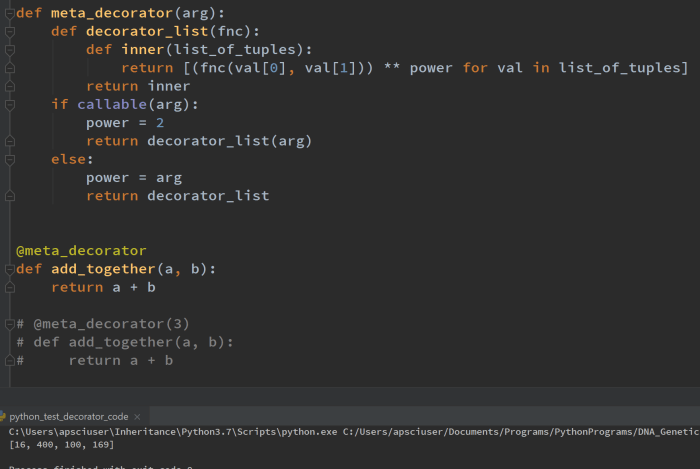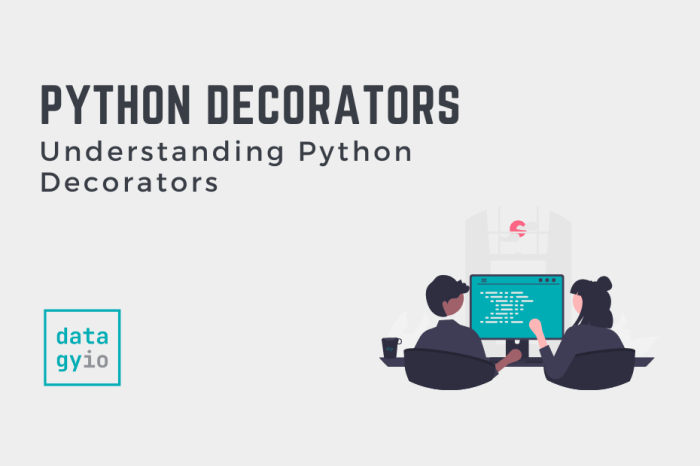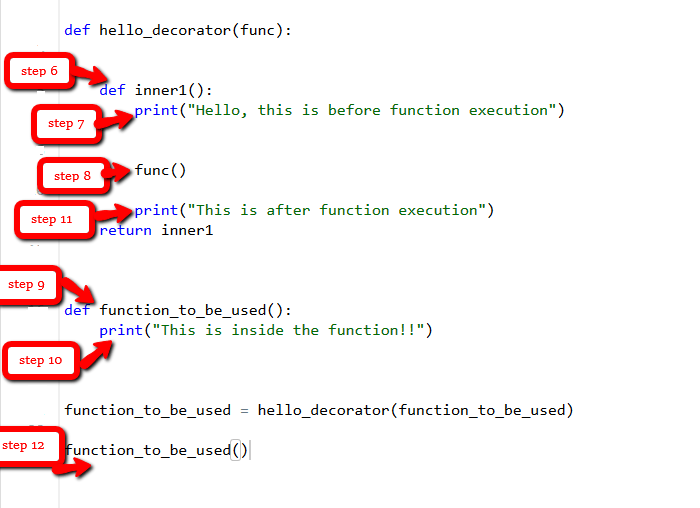How Python Decorators Work: Enhancing Code Functionality
Decorator Arguments

How python decorators work – Decorators, in their essence, are functions that modify the behavior of other functions. However, their power lies in their ability to accept arguments, which allows them to customize their effects dynamically. This section explores the concept of passing arguments to decorators and how they can be utilized to enhance their functionality.
Passing Arguments to Decorators, How python decorators work
Decorators are functions, and just like any other function, they can accept arguments. However, the way arguments are passed to decorators differs slightly from regular function calls. Consider the following example:“`pythondef my_decorator(func): def wrapper(*args,
-*kwargs)
print(“Before function call”) result = func(*args,
*kwargs)
print(“After function call”) return result return wrapper@my_decoratordef my_function(x, y): print(f”Calling my_function with arguments: x, y”) return x + ymy_function(2, 3)“`In this example, `my_decorator` is a simple decorator that prints messages before and after the decorated function (`my_function`) is called.
However, `my_decorator` itself does not accept any arguments.To pass arguments to a decorator, you can use a decorator factory.
Decorator Factories
Decorator factories are functions that return decorators. This approach allows you to create decorators with different behaviors based on the arguments provided to the factory.Consider the following example:“`pythondef repeat(num_times): def decorator(func): def wrapper(*args,
-*kwargs)
for _ in range(num_times): result = func(*args,
*kwargs)
return result return wrapper return decorator@repeat(3)def greet(name): print(f”Hello, name!”)greet(“Alice”)“`In this example, `repeat` is a decorator factory that takes an integer `num_times` as an argument. It returns a decorator that, when applied to a function, will call that function `num_times` times.The `repeat` decorator factory is called with the argument `3` and returns a decorator that is then applied to the `greet` function.
This results in the `greet` function being called three times when it is executed.
Common Decorator Use Cases: How Python Decorators Work

Decorators are incredibly versatile tools in Python, allowing you to modify the behavior of functions without directly altering their code. They are particularly useful for adding common functionalities that you might want to apply across multiple functions within your project.
Let’s explore some of the most common use cases for decorators.
Logging
Logging is essential for debugging, monitoring, and understanding the execution flow of your code. Decorators provide a clean and efficient way to add logging capabilities to your functions.
- A logging decorator can capture the function’s name, arguments, return value, and execution time.
- It can also log any exceptions that occur during function execution.
Here’s a simple example of a logging decorator:“`pythonimport logginglogging.basicConfig(level=logging.INFO)def log_execution(func): def wrapper(*args,
-*kwargs)
logging.info(f”Calling function: func.__name__”) logging.info(f”Arguments: args, kwargs”) start_time = time.time() result = func(*args,
*kwargs)
end_time = time.time() logging.info(f”Execution time: end_time
start_time
.4f seconds”) logging.info(f”Result: result”) return result return wrapper@log_executiondef my_function(x, y): return x + ymy_function(2, 3)“`This decorator will log information about each call to the `my_function`.
Python decorators are a powerful tool for adding functionality to existing functions without modifying the original code. They act as wrappers, allowing you to enhance or modify the behavior of a function before and after its execution. This is similar to how an interior decorator might add finishing touches to a room to enhance its overall appeal.
If you’re curious about the financial side of interior design, you can check out how much to interior decorators make. Returning to the realm of Python, decorators provide a concise and elegant way to streamline your code and improve its readability, much like a well-designed interior can make a space more functional and aesthetically pleasing.
Timing
Understanding the performance of your code is crucial for optimization. Decorators make it easy to measure the execution time of your functions.
- A timing decorator can calculate the time taken by a function to complete its execution.
- It can then display or store this timing information for analysis.
Here’s an example of a timing decorator:“`pythonimport timedef time_execution(func): def wrapper(*args,
-*kwargs)
start_time = time.time() result = func(*args,
*kwargs)
end_time = time.time() print(f”Function ‘func.__name__’ executed in end_time
start_time
.4f seconds”) return result return wrapper@time_executiondef my_function(x, y): time.sleep(1) # Simulate some processing time return x + ymy_function(2, 3)“`This decorator will print the execution time of the `my_function`.
Error Handling
Decorators can be used to handle errors in a consistent manner across multiple functions.
- An error handling decorator can catch specific exceptions and perform actions like logging, retrying, or returning a default value.
- This can help improve the robustness and reliability of your code.
Here’s an example of an error handling decorator:“`pythondef handle_errors(func): def wrapper(*args,
-*kwargs)
try: return func(*args,
*kwargs)
except ZeroDivisionError as e: print(f”Error: e”) return 0 return wrapper@handle_errorsdef my_function(x, y): return x / yresult = my_function(10, 0) # Will cause ZeroDivisionErrorprint(f”Result: result”)“`This decorator will catch any `ZeroDivisionError` and return 0.
Access Control
Decorators can be used to implement access control mechanisms, restricting access to certain functions based on user roles or permissions.
- An access control decorator can check the user’s credentials before allowing the function to execute.
- It can raise an exception or return an error message if the user is not authorized.
Here’s an example of an access control decorator:“`pythondef authorize(role): def decorator(func): def wrapper(*args,
-*kwargs)
if current_user.role == role: return func(*args,
*kwargs)
else: raise PermissionError(“Unauthorized access”) return wrapper return decorator@authorize(“admin”)def admin_only_function(): # Perform admin-level actions pass# Assuming current_user.role is “user”try: admin_only_function()except PermissionError as e: print(f”Error: e”)“`This decorator will only allow users with the “admin” role to execute the `admin_only_function`.
Caching
Decorators can be used to implement caching mechanisms, storing the results of expensive function calls to avoid redundant computations.
- A caching decorator can store the function’s return value in a cache (like a dictionary) based on its input arguments.
- On subsequent calls with the same arguments, it retrieves the result from the cache instead of executing the function again.
Here’s an example of a caching decorator:“`pythonimport [email protected]_cache(maxsize=None)def expensive_function(x): # Perform some expensive computation print(f”Calculating for x: x”) time.sleep(1) # Simulate expensive computation return x
2
for i in range(5): result = expensive_function(i) print(f”Result for i: result”)“`This decorator will cache the results of the `expensive_function` based on the input value `x`.
Decorator Best Practices

Decorators, while powerful, require careful consideration to ensure they remain maintainable and effective. Following best practices helps write clean, reusable, and easy-to-understand decorators.
Clear and Concise Naming Conventions
Consistent naming conventions are crucial for readability and understanding. Well-chosen names clearly communicate the decorator’s purpose and function.
- Use descriptive names that accurately reflect the decorator’s functionality. For example, instead of “decorator_1,” use “log_execution_time” or “cache_result.”
- Prefix decorators with “decorate_” or “with_” to signal their purpose. For instance, “decorate_timer” or “with_caching.”
- Follow standard Python naming conventions, using lowercase letters and underscores for multi-word names.
Reusable and Modular Decorator Functions
Aim for decorators that are flexible and adaptable to various situations.
- Design decorators to be as generic as possible. Avoid hardcoding specific values or functions within the decorator’s implementation.
- Employ parameters to customize the decorator’s behavior. This allows for flexible application across different scenarios.
- Consider using decorator factories to create specialized decorators based on specific requirements. For example, a “caching” decorator factory could generate decorators for different caching strategies (like in-memory, database, or file-based).
Decorator Documentation
Clear documentation is essential for understanding how decorators work and how to use them effectively.
- Provide a docstring for each decorator, explaining its purpose, arguments, and expected behavior.
- Include examples illustrating how to use the decorator in different contexts.
- Document any potential side effects or limitations associated with the decorator.
Avoiding Decorator Overuse
While decorators offer a powerful abstraction, overuse can lead to code that is difficult to understand and maintain.
- Consider the impact of decorators on code readability and complexity. Avoid using decorators for trivial tasks that can be handled with simple code.
- Prioritize clarity and maintainability over excessive use of decorators. In some cases, a simple function call might be more readable than a complex decorator chain.
- Evaluate whether the benefits of using a decorator outweigh the potential downsides in terms of complexity and maintainability.
Helpful Answers
What are the practical benefits of using decorators in Python?
Decorators offer several advantages, including:
- Improved code readability and maintainability by separating core function logic from additional functionalities.
- Enhanced reusability by applying the same decorator to multiple functions.
- Reduced code duplication, leading to cleaner and more concise codebases.
How do decorators handle arguments passed to the decorated function?
Decorators receive the original function’s arguments and pass them along to the decorated function. This ensures that the decorated function operates as intended, receiving the necessary inputs.
Can decorators be used with class methods?
Yes, decorators can also be applied to class methods. This allows you to enhance the behavior of methods within a class, adding functionalities like logging, timing, or access control.





